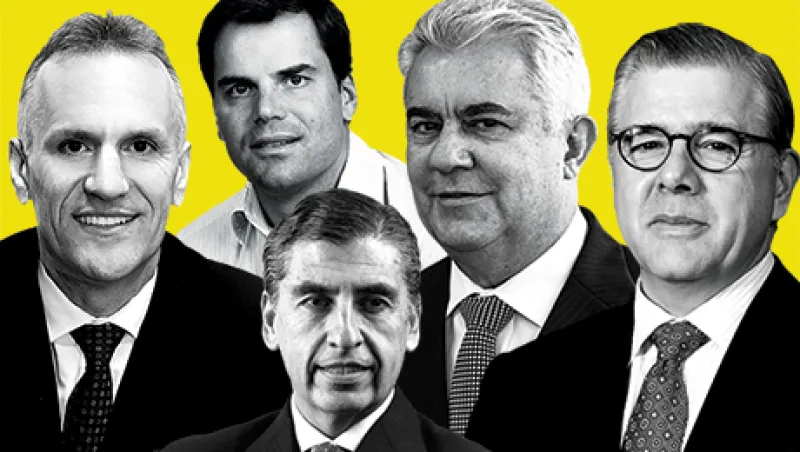Few companies have been as hard-hit by falling commodities prices as Brazilian mining behemoth Vale, the world’s largest producer of iron ore and nickel. The price of iron ore, for example, plunged from nearly $200 a tonne in 2011 to just over $50 by late August 2015 — and many market observers believe it will fall even further.
The Rio de Janeiro–based outfit faces an added challenge unique among its major competitors: the vast distance its products must travel to China, where the company earns 80 percent of its revenue. Its key rivals, Rio Tinto and BHP Billiton, have operations in Australia.
“Transport costs are very important in the industry,” explains chief financial officer Luciano Siani Pires. “Vale needs twice the effort of our competitors to stay competitive.”
As if these issues weren’t enough, China’s economy is no longer the growth engine it once was. The country’s central bank shocked global markets in early August when it devalued the renminbi, a move widely perceived as an attempt by the government to boost demand for exports as the nation’s economy expands at its slowest pace in 25 years.
This new landscape has required Vale to take action beyond the announcement of a new initiative or two. “It’s about shifting from the mind-set of abundance in the 2000s — where the market was screaming for products, and you would do whatever it takes to produce the additional ton — toward a mind-set of scarcity,” he says. “It means we need to focus on what adds value, really focus on margins — on optimizing everything from A to Z. Volumes are not as important; it’s profitable growth that is important.”
And on that score, Vale has been successful indeed. Since 2012 it has reduced its general and administrative expenses by some 70 percent, mainly by divesting itself of $12 billion worth of noncore assets. It dumped thermal coal assets in Colombia and dispersed interests in oil and gas, forests, and distributed energy generation, businesses that were taking up too much of management’s time and attention, Siani reports.
Vale has also slashed its iron-ore production costs from $26 per tonne in 2013 to $15.80 per tonne today. At the same time, capacity is on the upswing: The company has invested approximately $16 billion in the largest project in its history, the world’s biggest iron-ore mine, which will begin production next year in the north of Brazil.
In late July management reported that net profit had jumped more than 17 percent year over year in the second quarter, to $1.68 billion, putting the company in the black for the first time in a year.
“It’s been a relentless pursuit of a leaner company, a simpler company with fewer businesses but stronger businesses, with fewer assets but stronger assets, a very competitive cost structure and a relentless focus on return to shareholders,” Siani says.
Money managers and sell-side analysts are impressed. Vale claims the pole position on the 2015 Latin America Executive Team, Institutional Investor’s sixth annual ranking of the region’s top companies and corporate leaders as seen through the eyes of investment professionals. São Paulo’s Cielo, a credit card payments processor, takes the No. 2 spot, while Belo Horizonte, Brazil–based education services provider Kroton Educacional finishes third. A total of 98 entities make team; click on the Honored Companies link in the navigation table at right to view the full list.
Survey results reflect the opinions of 535 buy-side analysts and money managers at more than 290 institutions that collectively manage an estimated $267 billion in Latin American equities and of 345 sell-side researchers at close to 50 firms.
Latin American companies across multiple industries find themselves in circumstances similar to Vale’s: struggling to stay competitive in economies where growth is far from robust.
“The economic slowdown forces us to be more creative,” attests Humberto Reynaldo Nadal Del Carpio, CEO of Cementos Pacasmayo, one of the largest cement makers in Peru and the highest-ranked company in that country. (It’s No. 19 overall.) “It especially forces us not to lose the focus on the long term.”
The Lima-based building materials manufacturer’s net income surged 24 percent year over year in 2014, to 188.8 million soles ($63.2 million), even though sales increased by just 0.2 percent during the same period. In July the manufacturer reported that net income shot up nearly 20 percent in the first six months of 2015, to 96.5 million soles, even though sales volume had fallen by 6 percent. Moreover, its gross margin climbed from 40.5 percent to 43.1 percent, which executives attributed to cost-cutting initiatives and an increased focus on efficiency.
“Cutting fat in the company,” Nadal says, will position Cementos Pacasmayo for the boom times that he feels are just ahead. He points out that his organization holds a 97 percent market share in a region that has an enormous infrastructure deficit and adds that Peru is estimated to have a shortage of about 2 million homes. “We think that cement demand, aside from some years that are not so good, is going to be very strong in the next 20 years,” he contends.
To help meet that demand, Cementos Pacasmayo has invested $386 million in its third cement plant, in the city of Piura. Begun three years ago, the facility should be fully operational by the end of this year. Once it comes online, he adds, its production capacity will help increase earnings before interest, taxes, depreciation and amortization margins, which stood at 31.5 percent in the first half of this year, to about 35 percent.
SLC Agrícola, which comes in at No. 11, has followed a similar path, lowering costs as it prepares to meet rising demand. The worldwide need for food increases by about 3 percent each year, according to Aurélio Pavinato, CEO of Rio Grande do Sul, Brazil–based agricultural producer of corn, cotton and soybeans, but rock-bottom commodities prices are more than offsetting that growth in demand. The price of corn, for example, has fallen from more than $7 a bushel in 2012 to about $3.50 today. Pavinato says the executive team’s strategic response has been to increase the number and size of SLC Agrícola’s farms, and to benefit from the better efficiencies that come with scale.
“When we have more scale — bigger farms — it’s possible to use bigger machinery, and with the same machinery and same employees we can do more hectares,” he explains. “In the end, the cost per hectare or cost per bushel produced will be lower.”
Over the past three years, SLC Agrícola has expanded its arable land by 50 percent, and at the same time reduced its administrative costs per hectare by 30 percent. Pavinato notes that Brazil is one of the only countries in the world that still has the potential to expand the amount of land available for farming. “We believe that now is the time to increase the size of our planted area,” he adds.
Coca-Cola Femsa, operator of the largest independent Coca-Cola Co. products bottling group in the world, also sees opportunities for significant expansion in Latin America, even as some of its operations in the region struggle with strapped consumers and currency volatility.
“I continue to think that Latin America is a very attractive territory,” declares CEO John Santa Maria Otazua. “We’re going through some very volatile times right now, but it is a territory that has a very good demographic profile, with low per capita consumption of nonalcoholic ready-to-drink products — and it has a very good track record in terms of being able to come out of difficult positions.”
The Mexico City–based company, which ranks 17th on this year’s Latin America Executive Team, has introduced returnable plastic bottles in Brazil, a move designed to help consumers save money while also boosting consumption. “Brazil is down, and our operation in Brazil may be struggling, but we are gaining market share there,” he says. “When the market turns we’re going to be in great shape.”
In the Philippines — one of Femsa’s newer markets, and one Santa Maria hopes can develop into a larger foothold in Asia — it has introduced a 250 milliliter (8.45 fluid ounce) bottle, which he says allows the company to “connect with the consumer at a very affordable price.”
Another way the executive team is positioning the bottler to grow is by building out its offerings beyond carbonated soft drinks to include dairy-based beverages, energy drinks, juices, teas and water. In November, Coca-Cola Femsa opened a new facility in Brazil’s Minas Gerais to help support its multicategory product line there, and in February opened a bottling plant in Tocancipá, Colombia. Together, the facilities represent an investment of roughly $500 million.
At No. 9 is Tractebel Energia, one of the largest electricity producers in Brazil. The nation’s economic health is of paramount importance, as its home country is the only market in which the Santa Catarina–headquartered utility operates, but CEO Manoel Arlindo Zaroni Torres says the current downturn is actually bringing his company “relief.” Water shortages in the past two years have taxed Tractebel’s hydroelectric generators, he explains, requiring the utility to purchase energy at high spot prices to meet its contracted generation amounts. (Lower consumption requires the company to buy less energy at the higher rate.)
Still, Zaroni Torres says Tractebel will need Brazil’s fortunes to turn before long if his business hopes to keep growing — and he’s confident that it will. “The company believes in Brazil and is preparing itself for the moment when the company will grow again,” he says. “The investments we are making will allow us to keep the No. 1 position among private companies in the generation sector.” He adds that, over the medium and long terms, energy consumption in Brazil is sure to grow, especially in the less-developed regions of the country.
Executives at BRF, the Brazilian food giant created through the 2009 merger of Perdigão and Sadia (then the nation’s top two food producers), have been restructuring to streamline operations and maximize profitability. Pedro de Andrade Faria, who became CEO late last year, says the main goal has been to focus on what the Itajaí, Santa Catarina–based company does best, and that has meant shrinking its portfolio of goods by about half. The result is an emphasis on five core businesses: spreads, specialty meats, ready-to-eat dishes, poultry and pork cuts, and breaded poultry and pork items. Although BRF still carries approximately 1,600 products, it has disposed of two of its formerly major divisions: dairy and beef.
The strategy appears to be working. In July the company reported that year-over-year ebitda had rocketed 43.6 percent in the second quarter, to 1.38 billion reais ($436.9 million), and total revenue jumped 12.8 percent, to 7.91 billion reais.
“I really believe that during crisis time, the stronger get stronger and the weaker get weaker,” Faria says. “I think we are in a winning position, and we’ll continue to execute to be winners in this environment.”






